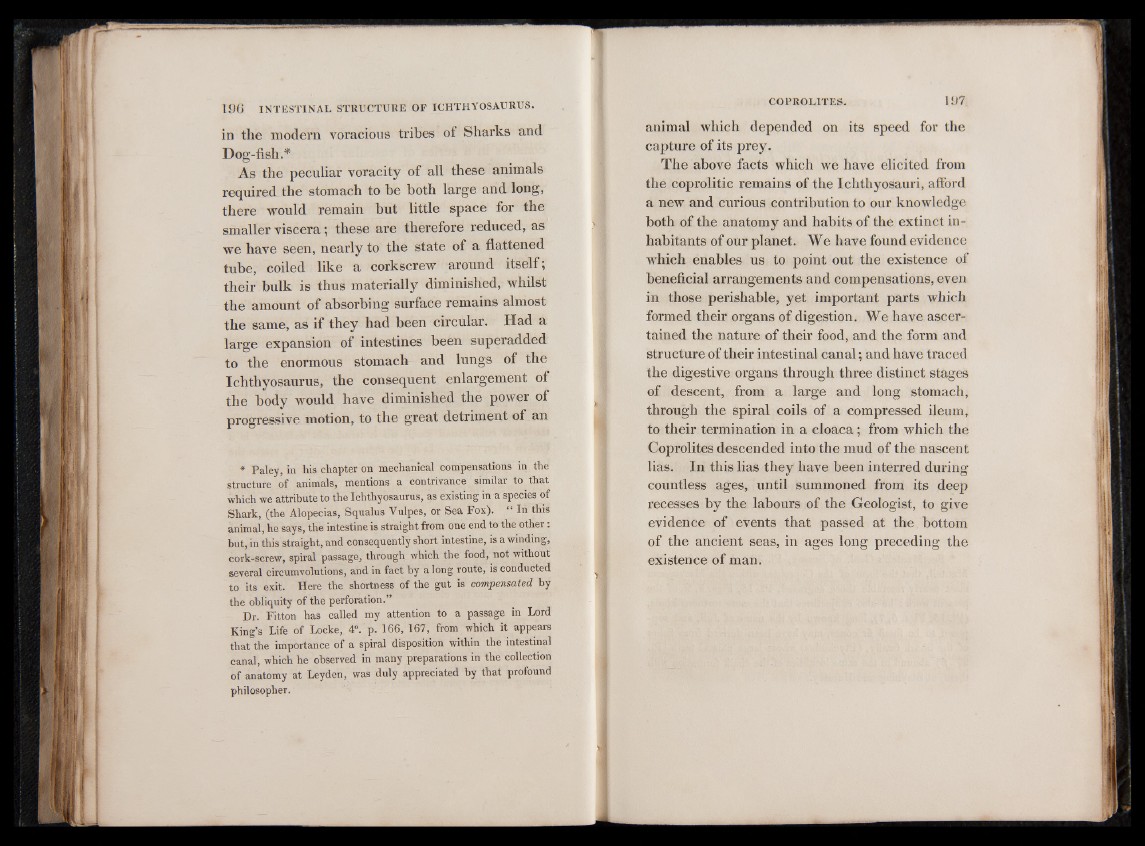
in the modern voracious tribes of Sharks and
Dog-fish.*
As the peculiar voracity of all these animals
required the stomach to be both large and long,
there would remain but little space for the
smaller viscera; these are therefore reduced, as
we have seen, nearly to the state of a flattened
tube, coiled like a corkscrew around itself;
their bulk is thus materially diminished, whilst
the amount of absorbing surface remains almost
the same, as if they had been circular. Had a
large expansion of intestines been superadded
to the enormous stomach and lungs of the
Ichthyosaurus, the consequent enlargement of
the body would have diminished the power of
progressive motion, to the great detriment of an
* Paley, in his chapter on mechanical compensations in the
structure of animals, mentions a contrivance similar to that
which we attribute to the Ichthyosaurus, as existing in a species of
Shark, (the Alopecias, Squalus Vulpes, or Sea Fox). “ In this
animal, he says, the intestine is straight from one end to the other :
but, in this straight, and consequently short intestine, is a winding,
cork-screw, spiral passage, through which the food, not without
several circumvolutions, and in fact by along route, is conducted
to its exit. Here the shortness of the gut is compensated by
the obliquity of the perforation.”
Dr. Fitton has called my attention to a passage in Lord
King’s Life of Locke, 4°. p. 166, 167, from which it appears
that the importance of a spiral disposition within the intestinal
canal, which he observed in many preparations in the collection
of anatomy at Leyden, was duly appreciated by that profound
philosopher.
COPROLITES. 197
animal which depended on its speed for the
capture of its prey.
The above facts which we have elicited from
the coprolitic remains of the Ichthyosauri, afford
a new and curious contribution to our knowledge
both of the anatomy and habits of the extinct inhabitants
of our planet. We have found evidence
which enables us to point out the existence of
beneficial arrangements and compensations, even
in those perishable, yet important parts which
formed their organs of digestion. We have ascertained
the nature of their food, and the form and
structure of their intestinal canal; and have traced
the digestive organs through three distinct stages
of descent, from a large and long stomach,
through the spiral coils of a compressed ileum,
to their termination in a cloaca; from which the
Coprolites descended into the mud of the nascent
lias. In this lias they have been interred during
countless ages, until summoned from its deep
recesses by the labours of the Geologist, to give
evidence of events that passed at the bottom
of the ancient seas, in ages long preceding the
existence of man.